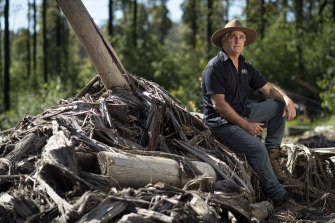The state government is increasing our bushfire risk right now
I have worked in the forests of Victoria since July 1983. Today I’m the most highly cited forest ecologist globally and have written 48 books on the subject.
One of the most difficult times in my career in that 40 years was after the 2009 Black Saturday fires, when friends died and my family’s farm was badly damaged. Later that year, while I was presenting a lecture, someone in the audience called out at me that if “Greenies like you” had allowed the forests to be logged and “properly” managed then the fires would not have been so severe and more than 100 lives could have been saved.
Professor David Lindenmayer, the most cited forest ecologist in the world, warns that actions in Wombat State Forest right now are increasing fire risk.Credit:Wolter Peeters
At the time, there was almost no science on links between fire and logging. My response was that his belief – that logged forests burn at lower severity than intact forests – needed to be put to thorough scientific testing. Nobody knew the answer.
More than a dozen years later, and after detailed studies following the 2009 fires and again after the 2019-2020 Black Summer fires, the science shows the opposite of the audience member’s interjection. That is, logged forests always burn at greater severity than intact forests.
This internationally accepted science also applies to salvage logging, like that happening today in wind-damaged areas in the Wombat State Forest, west of Melbourne. The state government, in allowing VicForests to perform this salvaging, is increasing the likelihood and severity of bushfires.
At first glance, one might think that logging and then removing fallen trees would reduce fire risks. Why do peer-reviewed scientific studies show that the opposite is actually the case? First, logging removes solid tree trunks but leaves behind branches, tree heads, bark and other debris. These remaining fine and medium fuels add to fire risk. Second, logging dries forest soils for up to 80 years after cutting. Third, important moisture-maintaining plants like tree ferns are almost completely lost from logged forest. Fourth, forests that are logged and regenerated are much hotter and subject to more extreme conditions than intact forests. Fifth, the dense understorey plants in young logged forest can create “ladder” fuels that drive surface fires into the canopy.
Our research following the 2009 Black Saturday fires showed that approximately 10 years after logging there was a seven times increase in the risk of high-severity fire. This sharply elevated risk lasts for around 30 years (that is, until the forest is about 40 years old). It then declines. The lowest risk is for forests 100 or more years old. That is, old forests burn at significantly lower severity than young forests.
The Black Summer fires provided an opportunity to further test logging and fire interrelationships. Analysis of data across the footprint of the 2019-2020 fire again showed that logged forests always burned at greater severity than intact forests. In addition, logged forest burning under moderate fire-weather conditions burnt at greater severity than intact forests burning under extreme fire weather. In some places there was a 25 per cent increase in fire severity in logged forests relative to intact forests.
The science is clear – logged forests add significantly to the fire burden in Victoria and NSW. Claims that salvage logging in the Wombat State Forest are essential to reduce the risks of wildfire are false. They are out of step with the extensive science on the effects of logging on fire risk.
I have been pressured by forest industry lobbyists not to highlight the links between logging and fire risk because it may hurt the feelings of people in the industry. Conversely, I believe it is morally and ethically irresponsible to not report key scientific findings that have implications for human safety.
Even from an economic perspective salvage logging makes no sense. The wood being removed is not fine quality timber. Almost all of it is going for cheap pulp (for paper manufacturing and making box liners). The taxpayer will be footing the bill for what is an uneconomic practice that creates greater fire risks.
All of the key scientific information on logging impacts has been provided to VicForests – but they have chosen to ignore the science.
The bottom line is that salvage logging operations should be halted immediately. Today. The Victorian government has the power to do this. The elevated fire risks in Victorian forests are already alarming and the problem must not be even further magnified.
Most Viewed in National
From our partners
Source: Read Full Article
